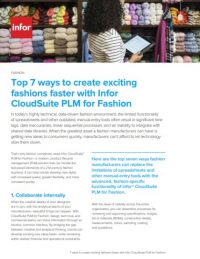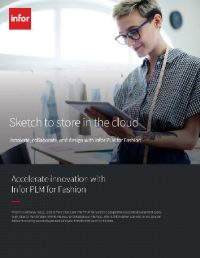Infor PLM for Fashion
Create value across your supply chain with Infor PLM for Fashion
Infor PLM for Fashion is a powerful product lifecycle management and collaboration tool. It empowers fashion companies to seamlessly link vital areas of the fashion value chain to their business processes – from planning, design, and development to supply chain sourcing and in-season consumer-driven design changes.
Key capabilities
Collaboration in real time
Material and trim development
Global solution
Customizable homepages
Connected design and data
Mobile-ready
What’s covered within an implementation?
- BOM and BOO configuration management
- Change management
- Critical path and milestones
- Integration
- Training
- Reports and query tool
- Product data management
- Partner management
- PLM customization
- Support
Get the desired business outcomes with our expertise in Infor PLM for Fashion and Infor CloudSuite Fashion integrations, which include Infor Document Management (IDM), report development, process automation, ION integration services, and workflows.

CloudSuite PLM for Fashion was rated 4.5 out of 5 stars for its user interface.
PLM Buyer’s Guide 2020 – WhichPLM
Request a Demo
Learn more about Infor Fashion PLM and how Fortude can help your business through its product life-cycle.
1st
enterprise-grade multi-tenant cloud PLM solution for the fashion market
Why work with Fortude?
Our roots are in Fashion
Fortude is part of the Brandix Group – one of the largest supply chain partners to retail brands in the US and Europe such as GAP, Under Armour, M&S and Lbrands.
A decade of excellence in Infor Fashion
We have delivered Infor CloudSuite Fashion, Infor M3, and related solutions to iconic fashion brands across manufacturing, distribution, retail, footwear, and industrial clothing verticals.
Fashion Center of Excellence
We have one of the largest M3 consulting resource bases in the world. Our Infor Certified consultants have many years of experience delivering functional and technical support across modules.
Choosing a PLM that best meets your company needs & budget
Before approaching the market and receiving demos from PLM vendors, carefully consider why you want a PLM solution in the first place. What is it that you want to improve? Do you have clear use cases in mind for PLM in core design and development and beyond? When it comes to answering this question, we would suggest that you focus on the critical functional must-haves rather than a long list of nice-to-have features that may eventually add value but are unlikely to deliver a return on investment in the vital early stages of the project. We would also suggest that you give extra weighting to the modules and processes that offer the greatest value to your business and your extended partners.
As an online, fast-fashion e-tailer, you are likely to only require a very simple tech-pack designed to help you create new styles quickly, supported by the right integration with Adobe Illustrator – and with sample sizing rather than using the full depth of the sizing module. In addition, you are likely to benefit from supplier collaboration capabilities and perhaps ready-made integration to one or more 3D solutions. As a retailer that sells its own private label merchandise, you might want to look for a PLM solution provider that is heavily focused on the retail sector and is more interested in planning, creative design, Adobe integration, storyboards, material development, high-level costing, PO management, packaging, labels, and sourcing.
As a brand that offers both fashion and technical products, it’s likely that you will want to find a vendor that is closely linked to brand customers. This would mean offering deeper design and development functionality, including merchandise planning, creative design, storyboards, 2D pattern engineering, sizing, 3D virtual design & development, material development, bill of materials, bill of labor & extended costing, components, packaging, labels, sourcing, full partner collaboration, and tracking.
As a manufacturer, you may be looking to PLM to improve your business’s efficiency and offer closer collaboration services to your customers. If so, perhaps your business may be interested in co-design creative solutions including 2D pattern engineering, 2D creative & technical design, 3D design to engineer/make, sizing management, BOM, BOL, extended costing, material development and color management, CSR, sustainability, real-time shop floor tracking, and capacity management.
Until recently, technical specifications were typically shared between customer and supplier as PDFs via email. This process was replaced by dedicated vendor portals introduced by PLM vendors to bridge the gap between live PLM data and static email. Vendor portals essentially offered the same process but placed the Tech-Pack PDF into a central location to be downloaded and uploaded by the supplier with some level of accountability. More recently, we are seeing customers and suppliers sharing the same PLM platform with the ability to work on a single style in real-time, with no “dead” data, along with full access and restricted security. We would strongly recommend the latter as the best-practice approach – and while it may not always be feasible to make PLM accessible to your suppliers early in the project, this extension should be considered a priority for the next phase once your PLM solution is being used to its full potential in-house.
This greatly depends on the complexity of your business. Are you operating on an international level? Do you have multiple brands? Do you have a complex product range? The list of questions can go on and on. Assuming you’re a medium-sized operation and want to use a configurable, out-of-the-box PLM solution adhering to best practices, you will be looking at a duration of somewhere between four to six months. Note that this will be subject to the answers given to the above questions and could be reduced or go much higher – it’s all relative to the complexity.
It will be important that you look for a PLM vendor that specializes in your product sector. It’s relatively easy for PLM vendors to develop a nice looking footwear or knitwear presentation, only for the prospective customer to dig a little deeper and find that they have no real product expertise or customer references. There are several specialized vendors that support footwear and knitwear products, so make sure that you look at every vendor carefully and assess their credentials when it comes to supporting your unique business mode.
Source: WhichPLM Buyer’s Guide
Meet challenges to your product lifecycle
Infor CloudSuite PLM for Fashion can help meet product development challenges by:
- Improving efficiency and reducing costs
- Improving the bottom line
- Building an intelligent workflow
- Accelerating product development and innovation
- Reducing re-work associated with product creation
Faster & smarter implementation
With the right solution, you can manage complexities and automate processes from product ideation to product recycling. And with our team of experienced fashion consultants, you can reinvent your product development workflow and navigate every stage of the PLM deployment.
- Unify PLM data and processes across the enterprise
- Integrate PLM data with internal and external systems
- Achieve faster implementation of the PLM solution with greater efficiency


